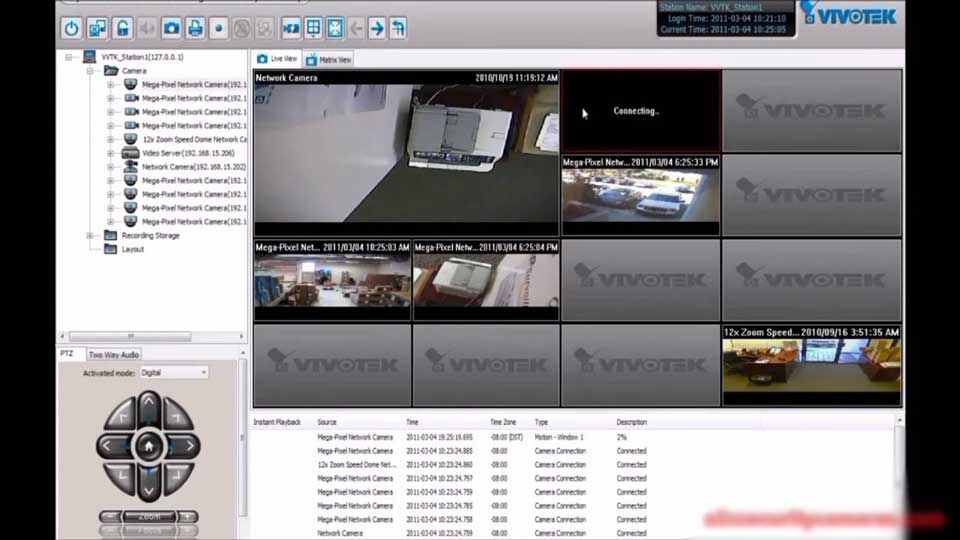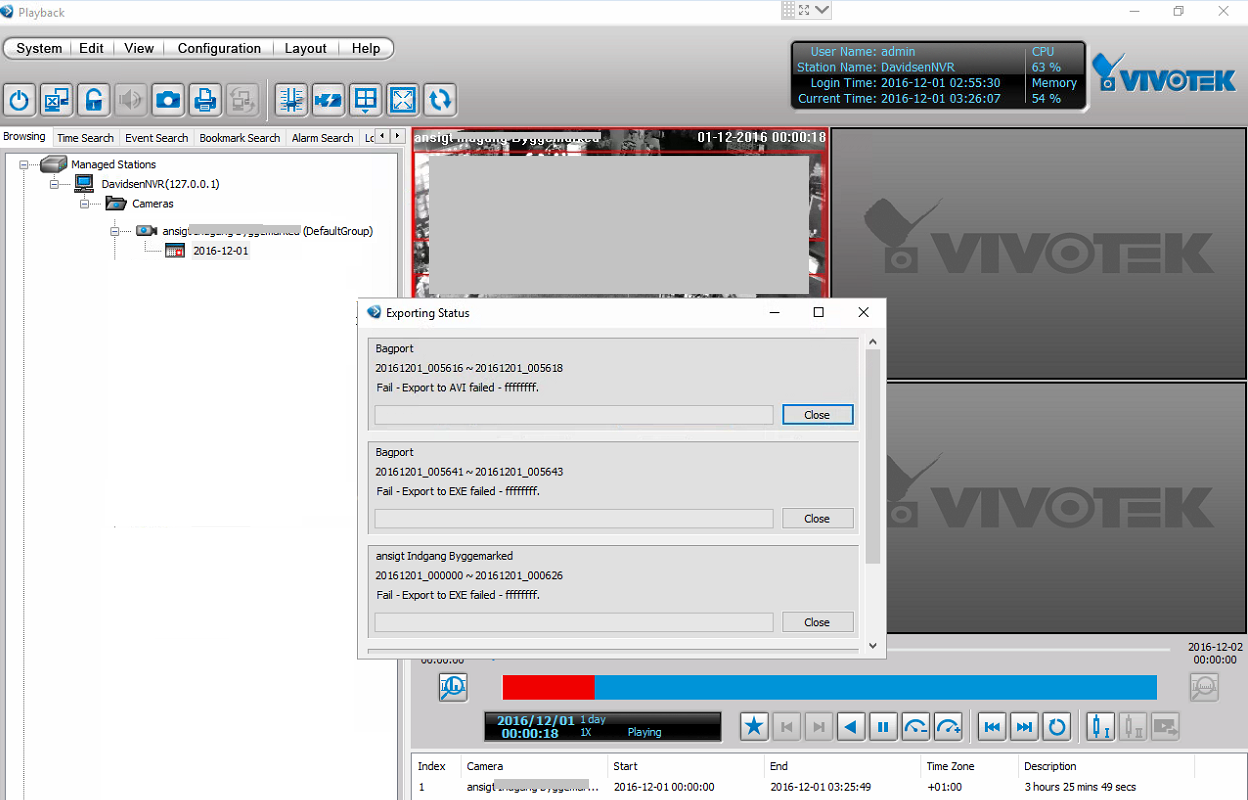VAST Security Station complete guide,Cameras equipped with VIVOTEK Vision Object Analytics eliminate the need for complicated calibration and instantly send metadata to the server, saving you time in configuring the camera. Choose VIVOTEK Vision Object Analytics and VAST Security Station to quickly establish your A.I. surveillance system and reduce your efforts. Just plug in and get started!
How to do when UI is transparent?
VAST2 UI (version: 2.0.0.1650) is transparent on Windows 10 of Hyper-V VM. I can see overlap issue between UI and shortcuts on desktop.
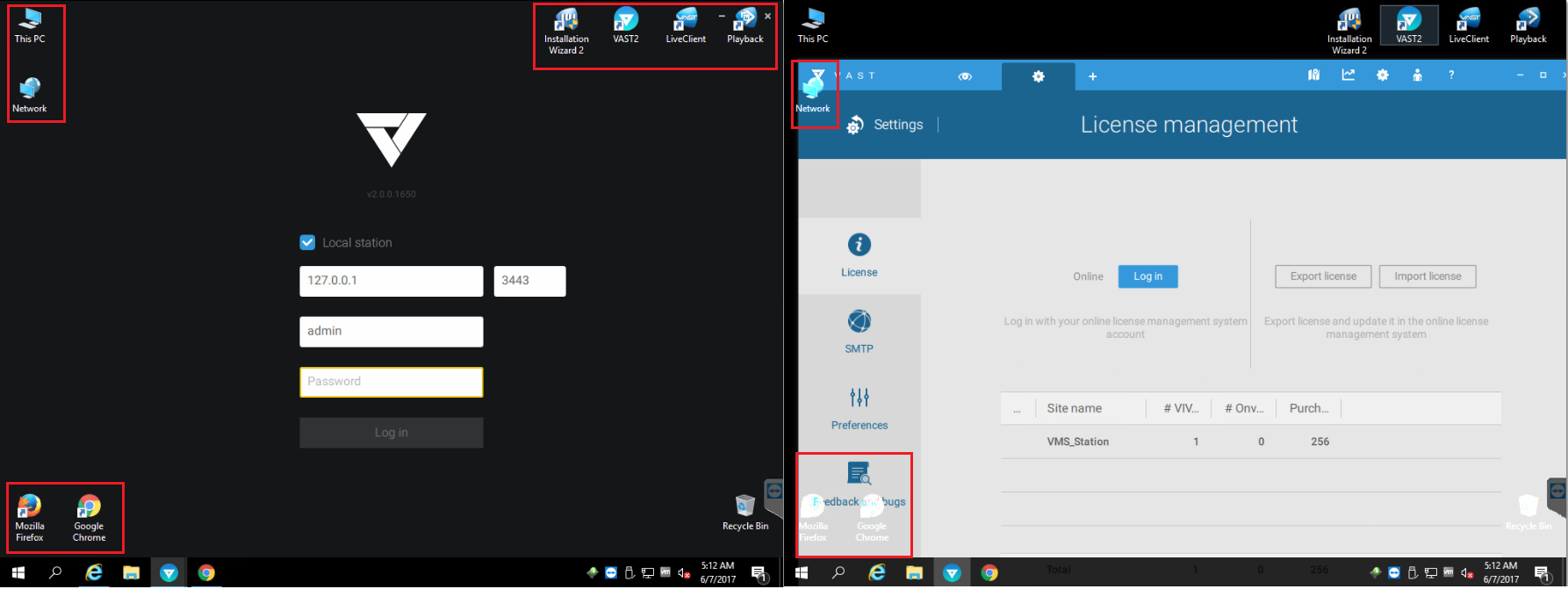
ANSWER
Please follow below steps to solve the issue.
1. Go to “Display Setup” file location.
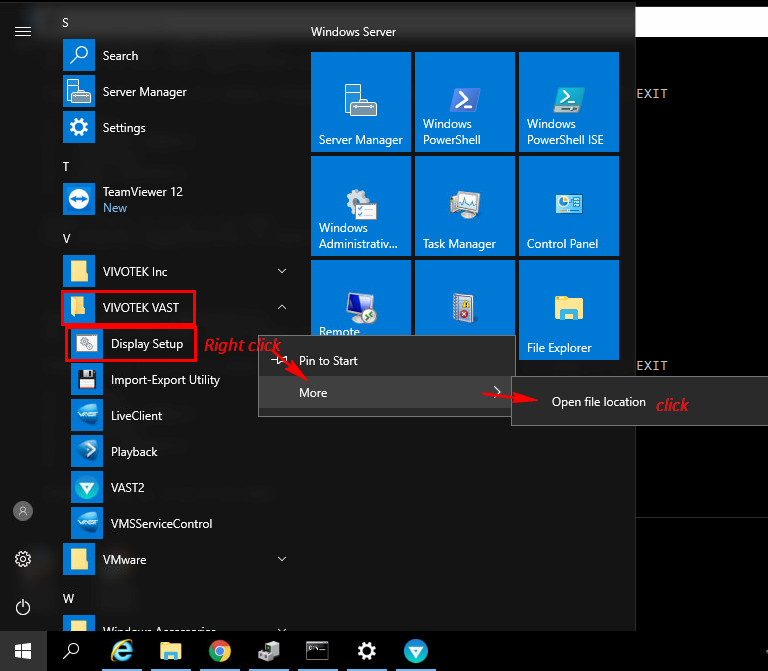
2. Right click “Display setup” and run as administrator.
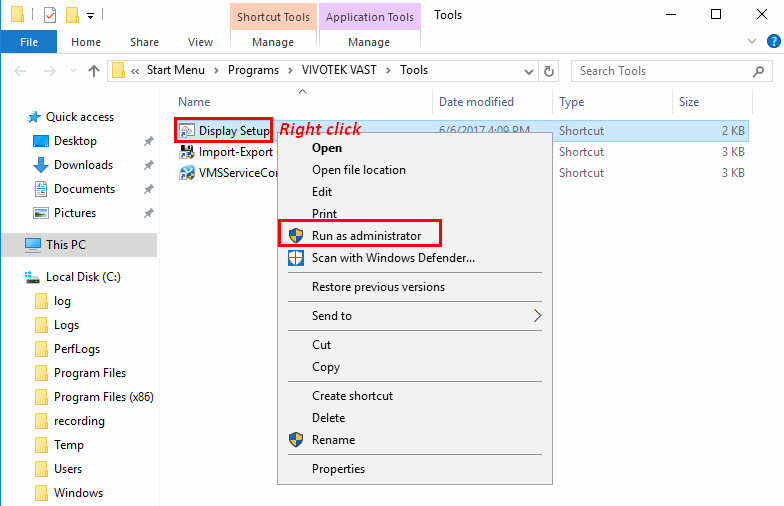
3. You will see Display setup window and then Press A.

Finished above steps, VAST2 UI will not be transparent.
VAST Security Station complete guide
Read More :
How to update camera list of substation when there are new inserted cameras
QUESTION
I inserted new cameras on the substation under VAST2.
However, I can’t see the new cameras on VAST2.
How to update camera list of substation when there are new inserted cameras?
ANSWER
Please refer to attached document
What is Virtual Matrix on VAST?
Introduction
VIVOTEK provides a professional video wall solution, Virtual Matrix, a new feature in VAST version 1.5. Since its introduction, Virtual Matrix has been upgraded to support live views of an unlimited number of channels from the previous 64 channels. In addition, live views on an unlimited number of screens for an unlimited number of cameras are available, whereas the original version supported a maximum of 2 screens.
This document provides a general introduction to VAST Virtual Matrix along with explanations of how to set it up.
What is VIVOTEK Virtual Matrix?
The Virtual Matrix feature has been added to VAST to enable a more powerful surveillance setup in the central control room through support of multiple monitors.

LiveClient and VAST server work with Virtual Matrix to display an unlimited limited number of channels on an unlimited number of screens.
We have implemented the Matrix recipient control in LiveClient, allowing the user to control and configure Virtual Matrix. The Virtual Matrix recipient will be installed on other computers with multiple screens.
When LiveClient logs into the server, the user can set up a connection to the Virtual Matrix recipient, which needs to be started up first.
Once connected, the user can display the cameras on the screens of other computers through simple point-and-click operations. There is no limit to the number of screens, recipient connections, or camera feeds that can be displayed.
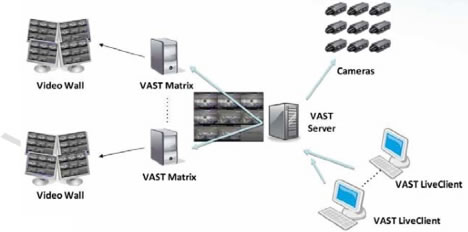
Why Use Virtual Matrix?
- Powerful
- Unlimited number of channels – Virtual Matrix removes the upper limit of 64 viewable channels, allowing you to view an unlimited number.
- Unlimited number of screens – The upper limit of 2 screens for displaying channels has been removed, allowing an unlimited number of screens to be used for displaying feeds from an unlimited number of cameras.

- Superior picture quality and coverage – For improved surveillance, Virtual Matrix provides not only extremely clear and detailed picture quality, but also much expanded coverage with advanced cameras of 2-megapixel resolution or higher.
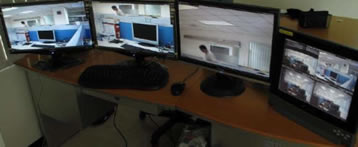
- Easy to Use
- Flexible arrangement of selected camera feeds – Click the Layout button on the quick access bar. Select the desired layout mode and the arrangement of the channels will change accordingly. Eight layout modes and the corresponding number of video pages are listed below.
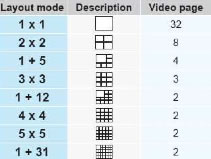
- Rotate camera for greater coverage The video pages will start to rotate so that the user does not have to click to move to the next page.
- Drag-and-drop support cell. To move a video channel to an empty video cell, simply drag the view to the desired

To exchange the locations of two channels, drop one view onto the other.

- Easy searching Click to search for VAST Matrix recipients on the LAN.
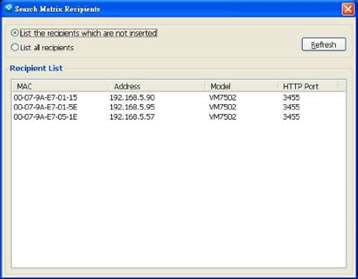
- Flexible arrangement of selected camera feeds – Click the Layout button on the quick access bar. Select the desired layout mode and the arrangement of the channels will change accordingly. Eight layout modes and the corresponding number of video pages are listed below.
- Other Benefits
- Each VAST Matrix supports up to 10 monitors and 320 channels.
- Supports Key Frame Only mode – This mode allows VAST Matrix to receive all video frames, but only decode and display the key frame.
- Supports virtually all VIVOTEK products VAST Matrix supports all VIVOTEK cameras, NVR, and video servers (except NR7401).
- Low cost – Allows monitoring of numerous cameras feeds using only a few computers.
Minimum System Requirements
Before installing the VAST Matrix, please make sure your system meets the following recommended minimum system requirements.
| Channels | Fewer than 16 channels | 16 ~ 32 channels | 32 ~ 40 channels | More than 40 channels |
| CPU | Core 2 Dual E6400 2.13GHz or above | Core 2 Dual E8600 3.33GHz or above | Core 2 Quad Q6600 2.4GHz or above | Core i7 |
| RAM | 2GB or above | 3GB or above | 4GB or above | |
| NIC | Ethernet, 1Gbit recommended | |||
| Graphics Adapter | AGP or PCI-Express, minimum 1024×768, 16 bit colors Minimum 128MB Video RAM, 512MB recommended | |||
How to set up Virtual Matrix?
- Activating VAST Matrix After installing the VAST Matrix program, which runs as a standalone Windows, application on the remote computer, follow the steps below to activate it:
- Run the VAST Matrix program.

- By default, a single camera feed is displayed full-screen.

- Run the VAST Matrix program.
- Settings of VAST – After running VAST Matrix, you must go to VAST to set up the settings of Matrix.
- Run the VAST LiveClient program.

- Click Matrix View, and then select Configuration > Virtual Matrix Management > Matrix Management… to bring up the setup window.

- You can click to search for Matrix recipients on the LAN or add a new matrix recipient by entering its IP address, account name and password.
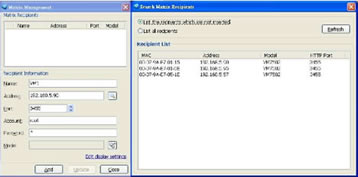
- Click “Edit display settings to bring up the Display Settings window, where you can set the rotation interval, enable de-interlace mode, and toggle the display key frame only feature on or off.
- Enablede-interlace:Enhancesthedisplayedvideoqualityforsomecamerasthat do not have built-in de-interlacing capabilities. (Note: Increases processing overhead.)
- Displayonlykeyframe:VASTMatrixwillreceiveallvideoframes,butwillonly decode and display the key frame. (Note: This setting will not have any effect if the codec used is MJPEG.)
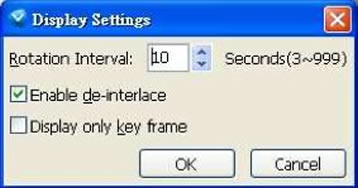
- Click Add to add the new matrix recipient to VAST, and display information on the associated Matrix View.
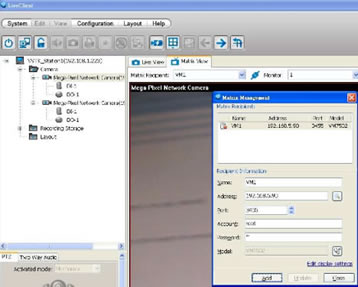
- You can drag and drop a device from the hierarchical management tree to a Matrix video cell.
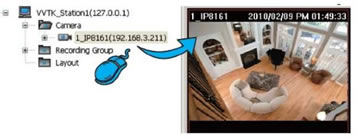
- Right-clicking in the video cell allows you to select the displayed stream. For multiple-stream devices, you can select individual streams.
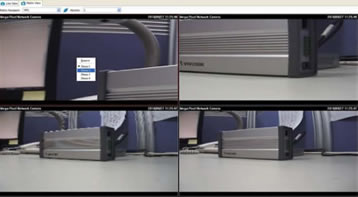
- You can click the layout button to change the arrangement of channels on each monitor (up to 32 channels).
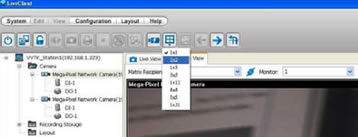
- Click Layout > Start Rotation on the menu bar (it will then change to Stop Rotation), or click the Rotation button . The video pages will start to rotate so that the user does not have to click to advance to the next page.
- In Matrix View Settings – Media source:
- Directlyfromcamera:EnablestheMatrixtofunctionindependently—forexample, allowing you to view the Matrix even when the VAST server is offline.
- FromCMSserver:Reducestheloadingincamera,butnotethattheMatrixwill not be functional without VAST.
- In Matrix View Settings – Display Settings:
- Fullframerate:Displaysvideoatthefullframerate.
- Keyframeonly:DisplaysonlythekeyframetoreduceCPUload.
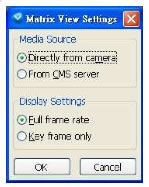
- Run the VAST LiveClient program.
VAST Matrix settings
After you have completed setup of Virtual Matrix, you can go to VAST Matrix to further configure Matrix.
- Right-click anywhere in the window to bring up the popup menu. The menu contains the items Configuration, View Settings, About, and Exit.

- In the Connection page of the Configuration window, you can change the port used by Matrix (the default is 3455), account (the default is root), and password.
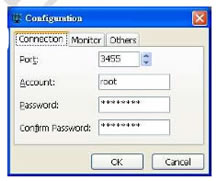
- In the Monitor page, you can select monitors for display.
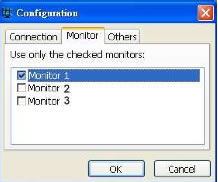
- In the Others page, you can enable various options.
- Auto launch at Windows startup: Enable this option to start VAST Matrix automatically when logging into Windows.
- Display only key frame: VAST Matrix will receive all video frames, but will decode and display the key frame. (Note: This setting will not have any effect if the codec in use is MJPEG.)
- Enable de-interlace: Enhances the displayed video quality for some cameras that do not have built-in de-interlacing capability. (Note: Enabling this feature will increase the processing load on the system.)
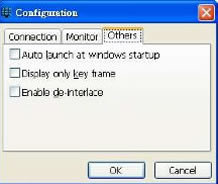
- In the View Settings window, you can set how individual video cells will be displayed.
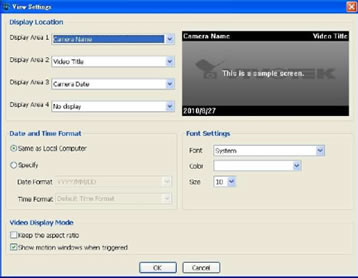
- If a user selects “Exit, it will close Matrix and VAST will not be able to control it further.
Setting up multiple monitors
This section describes the setup of VAST Matrix for use with multiple monitors, using an installation with four monitors as an example.
- Prepare graphic cards with more than a single port.
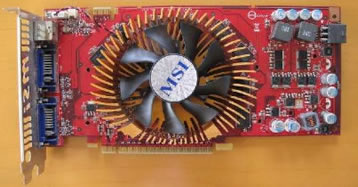

Note: To ensure compatibility, choose graphics cards from the same vendor as the system’s graphics processor—for example, NVIDIA or ATI.
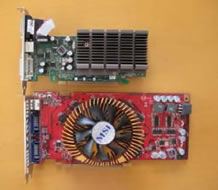
- The system motherboard must support multiple graphics cards.
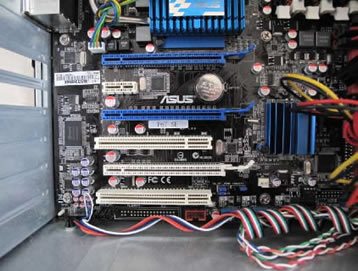
- Install the two graphics cards on the motherboard.
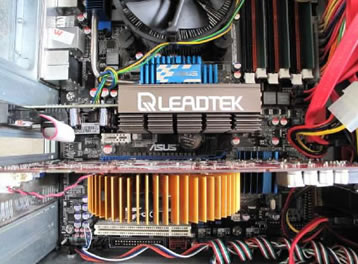
- Set up the monitors.

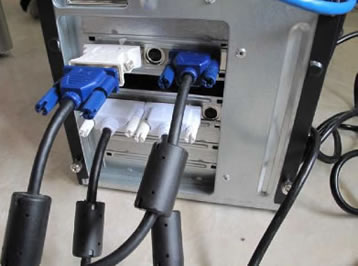
Note: Each graphic card has a specific type of connector. Some of the most common ones are Mini Display, DVI and D-Sub.
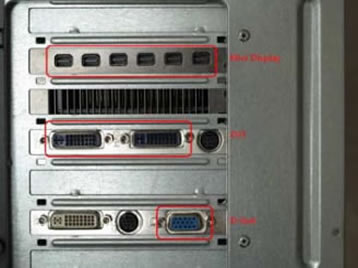
- Start up the computer system, and make sure all the graphics cards are detected. You can set the display order as desired.
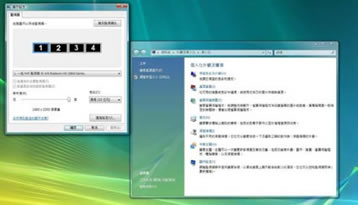

- After setting up multiple monitors for display using VAST Matrix, you can have a video wall like the one shown below.
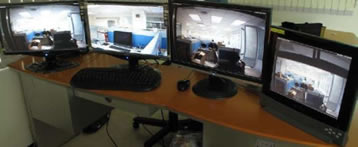
Why does VAST playback show export failed ffffffff while exporting video clips?
|
||
Answer |
|
|
Why is network throughput more than the bit rate in camera video setting page?
Question
Why is network throughput more than the bit rate in camera video setting page?
Answer
Network throughput which shows in VAST LiveView includes the bit rate of video and audio of the camera required.
If you would like to check what bit rate of video requires, please enable “Mute” feature in camera audio setting page.
How to enable the SD9365/SD9366 wiper in the VAST LiveClient using the DO?
Question
How to enable the SD9365/SD9366 wiper in the VAST LiveClient using the DO?
Answer
The wiper control function is not integrated in the VAST LiveClient, this function was only implemented in the VAST2. If you require to control the wiper using the LiveClient, it is necessary to link the wiper to the DO trigger (can be controlled in the LiveClient). Note: before starting the configuration, be sure to enable the “Keep detecting DI/DO status” in the VAST Configuration > Client Settings > General Settings otherwise you wont be able to enable the DI/DO in the VAST device tree.
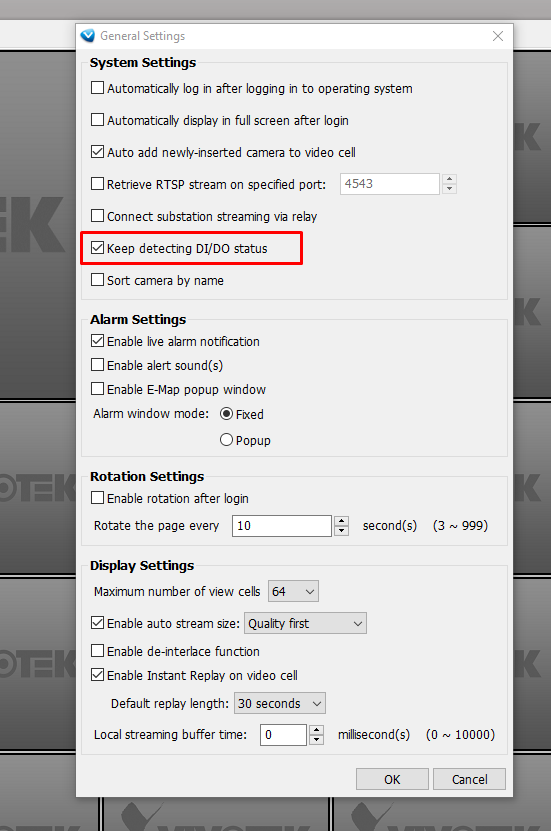
Please follow the next steps to configure the wiper using DO:
Step 1. Be sure that the DO is not being used in the SD9365/SD9366.
Step 2. Access the VAST LiveClient.
Step 3. Go to Configuration > Alarm Management… to set an alarm.
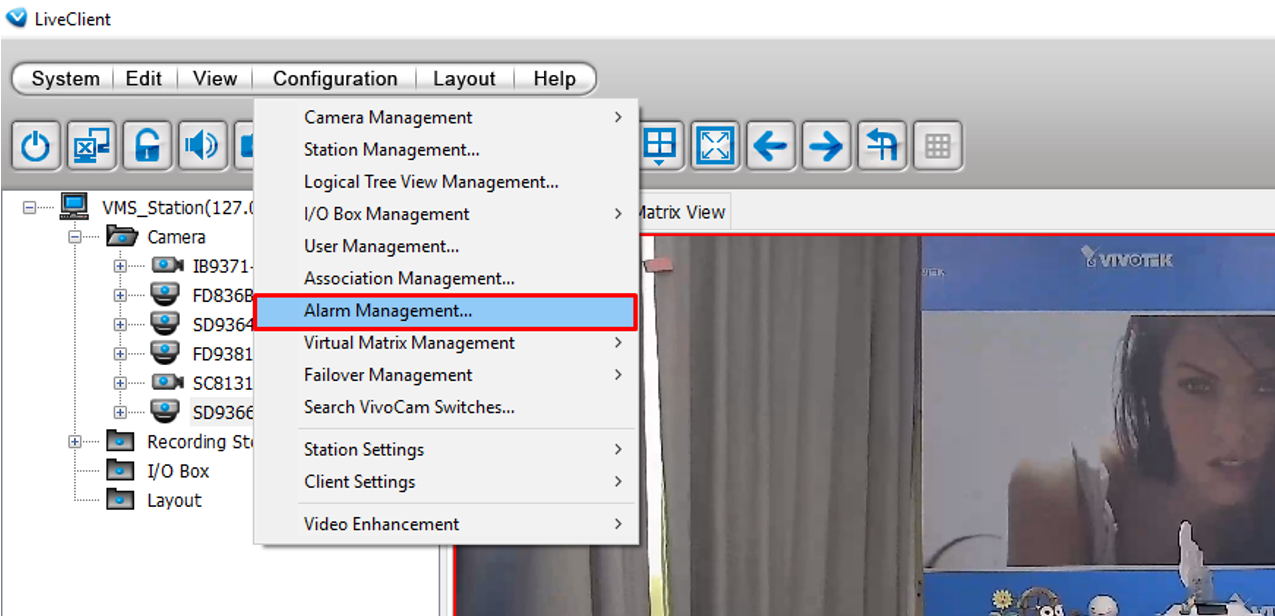
Step 4. In the Alarm Management window click “New”.
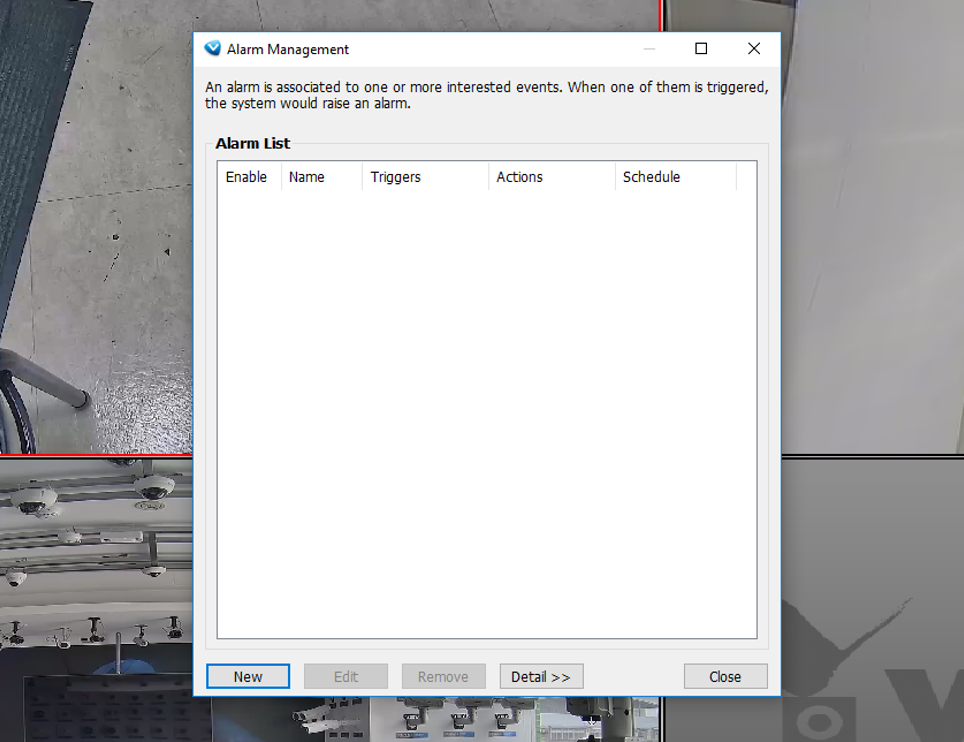
Step 5. Name your alarm (in this example we used “Move wiper”, but you can name the alarm as you like) and click Next.
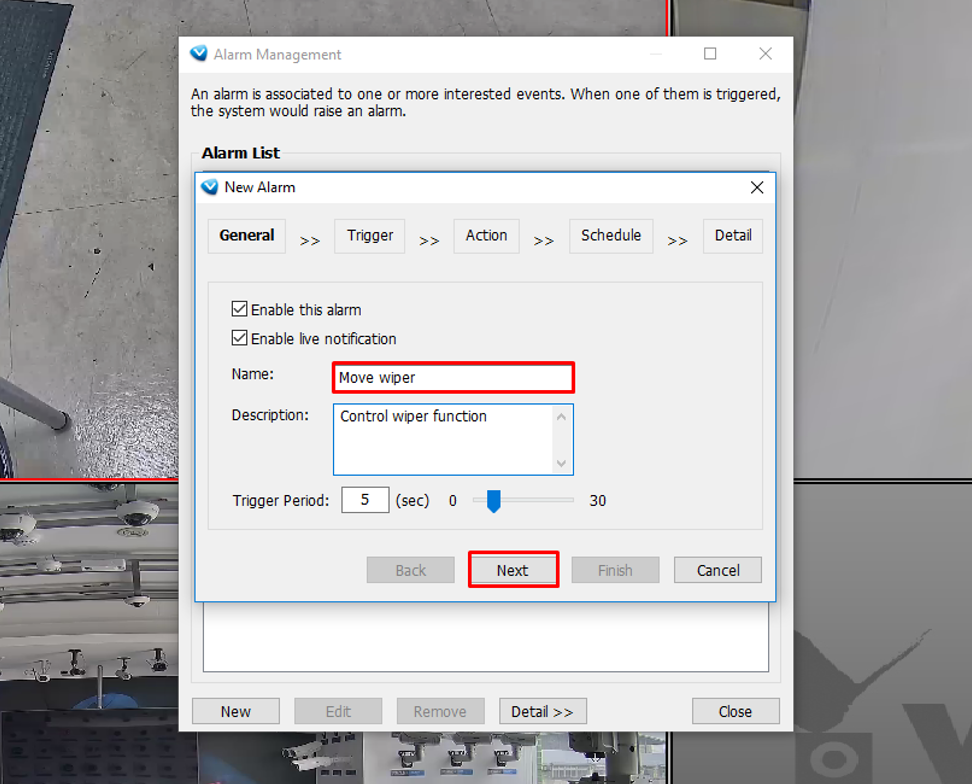
Note: adding a description is optional.
Step 6. In the “Trigger” section, click on the “Add” button,
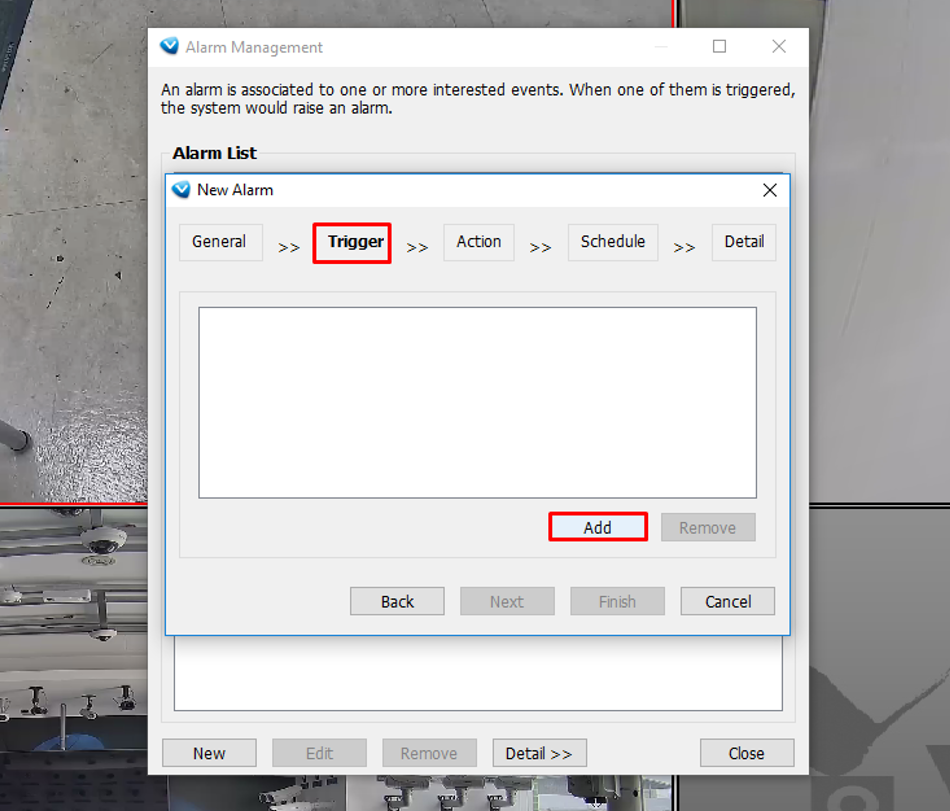
Then, choose the event as “Trigger type” (this will let the software know that is a trigger action), the category as “Camera events” (this will check the camera status) and be sure to select the “DO-1” as the type and click “OK”.
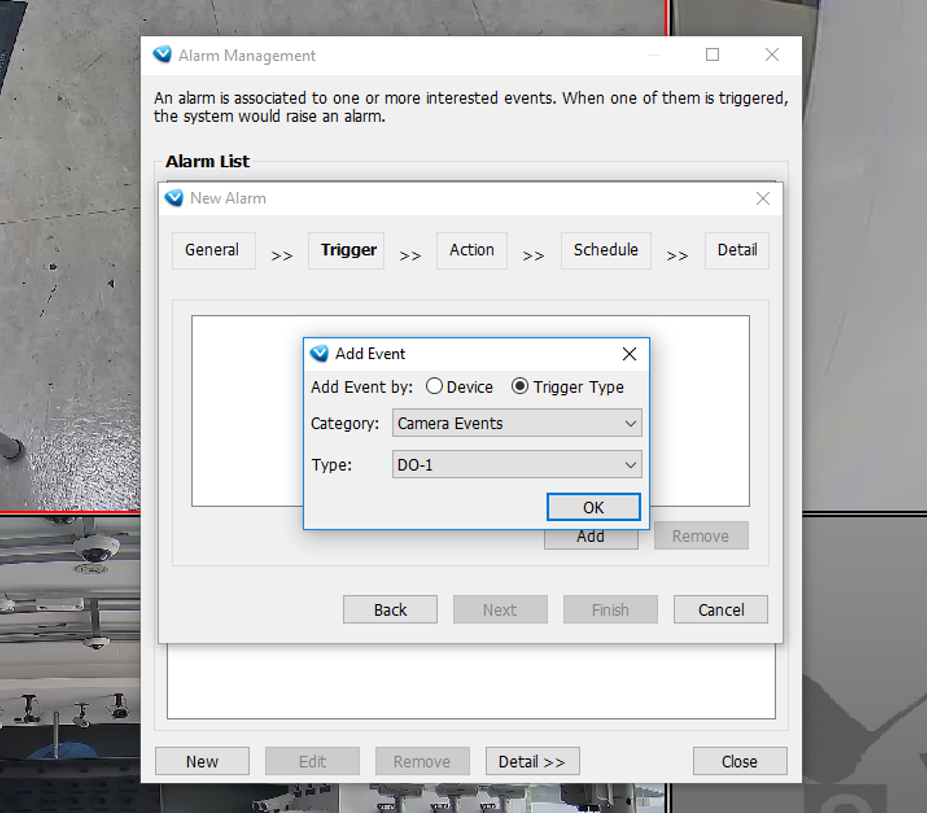
Note: you can also select another DO if available.
Step 7. In the Device List -DO-1 window, select the SD9365/SD9366 camera.
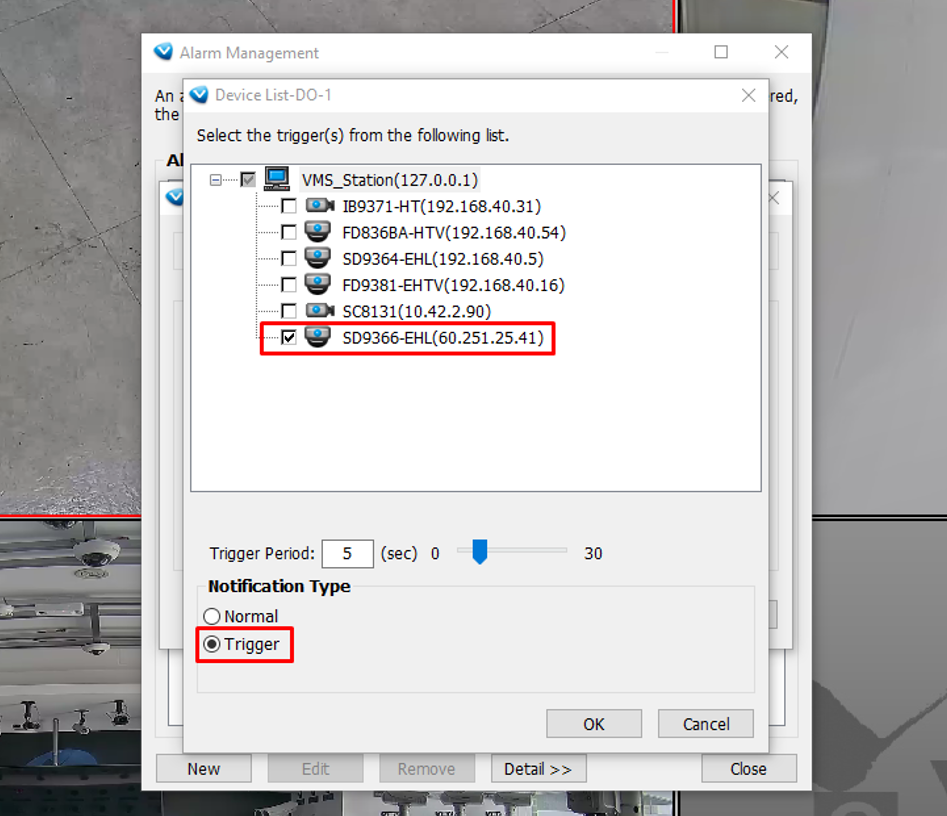
Be sure the Notification type is set to “Trigger” (this will check if the DO changed from Normal to Trigger). Then, click “OK”.
Step 8. Double check that the trigger has been saved, then click Next.
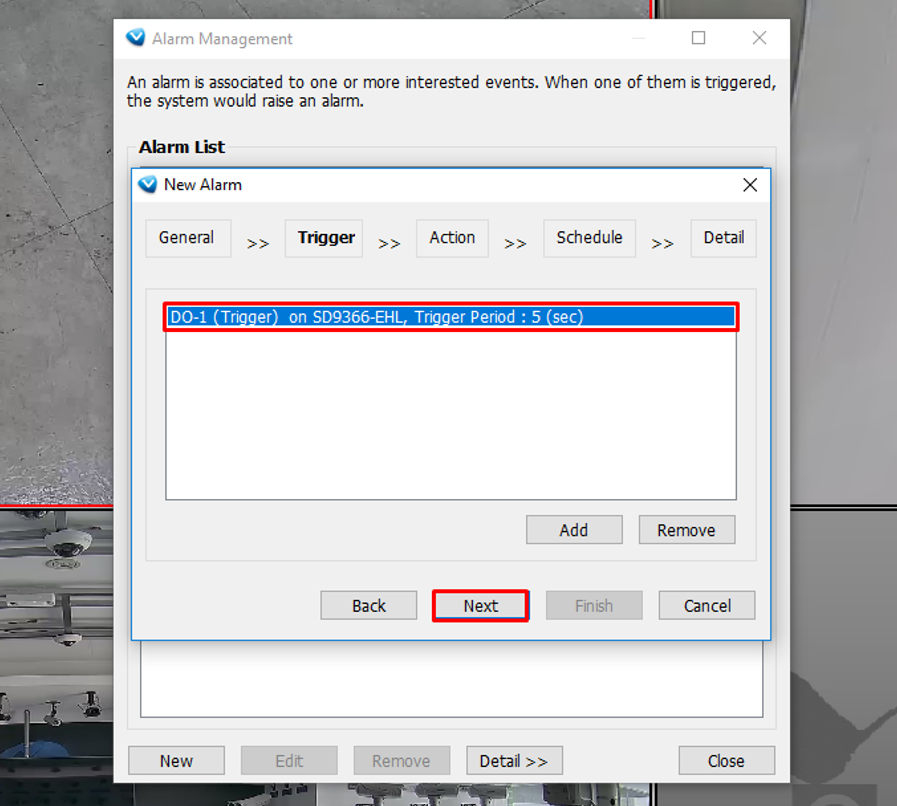
Step 9. In the “Action” section, click on the “Add” button to add the action to be performed (Wiper movement).
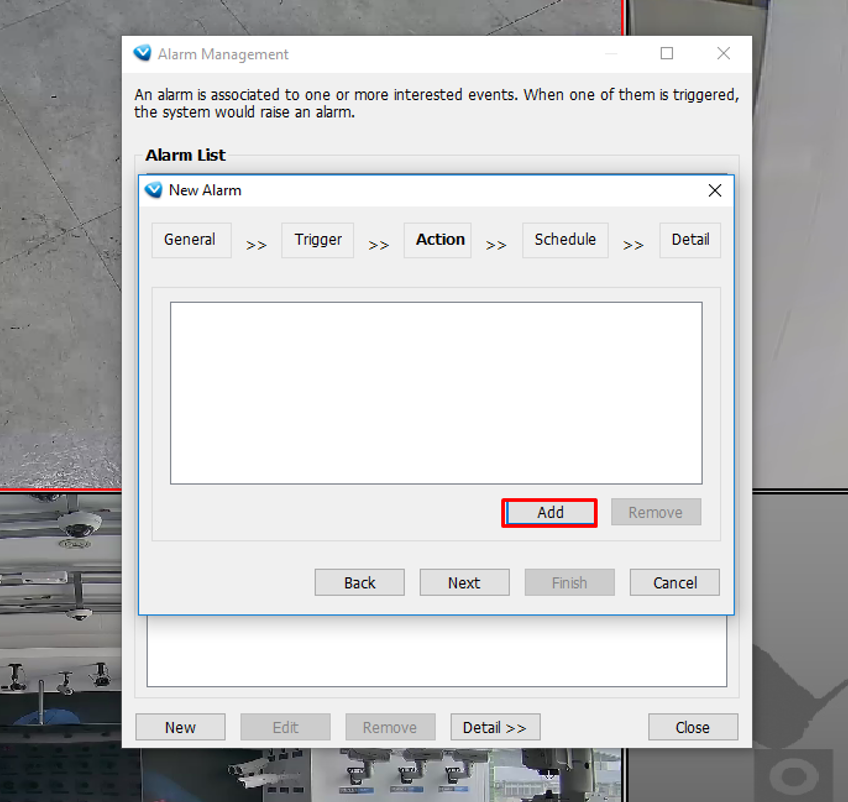
Step 10. In the “Action” window, select the HTTP action, then use the following URL to enable the wiper in the camera:
http://<camera IP>/cgi-bin/admin/peripheral.cgi?channel=0&operation=set& washer_mode=wiper&washer_status=on
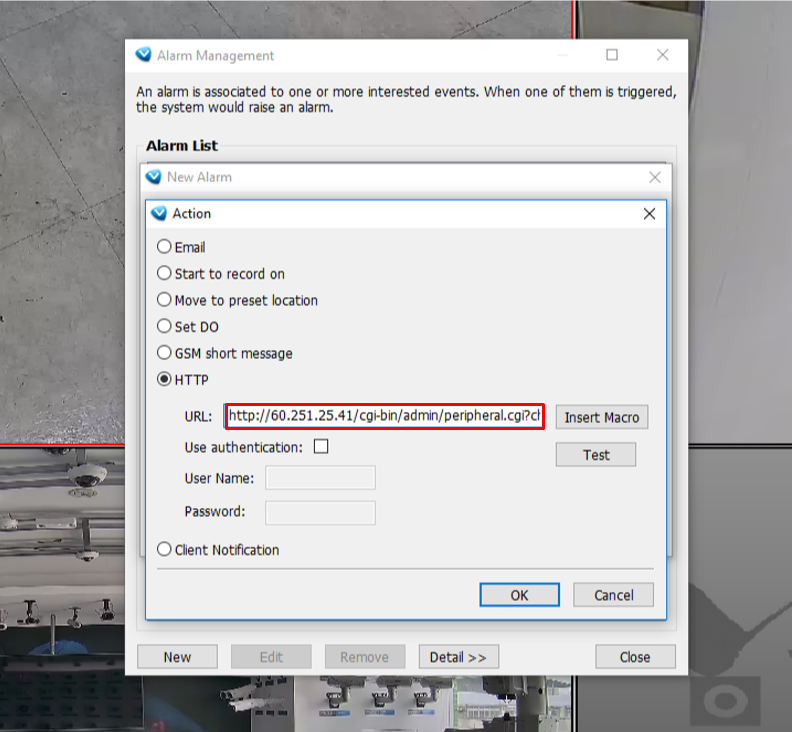
So, each time the DO is enabled, it will send this command to the camera and the wiper will move. Note: be sure to authenticate the command, otherwise the camera will block the request.
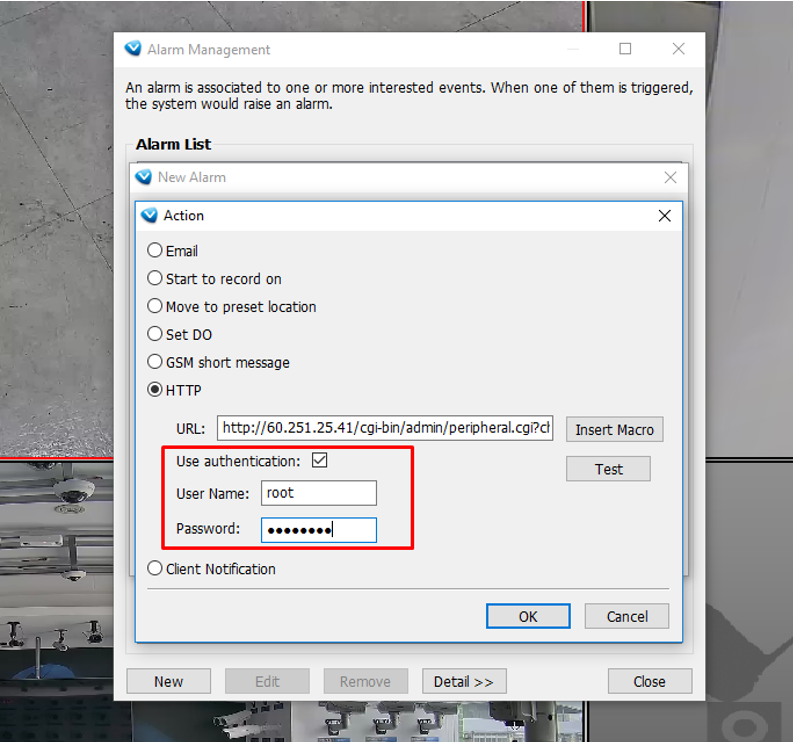
Step 11. Be sure that the action was correctly saved and then press “Next”.
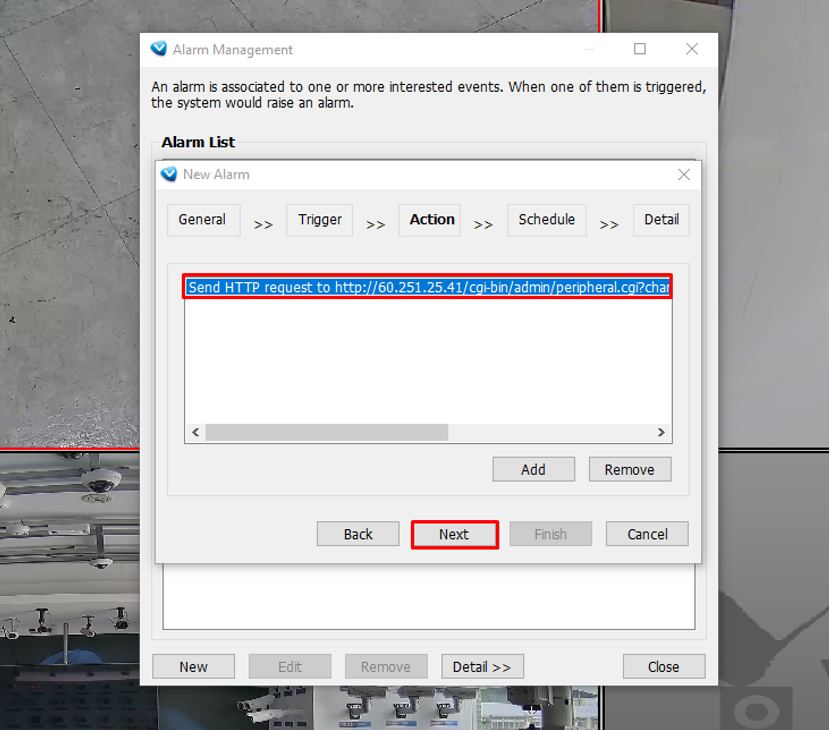
Step 12. Keep the schedule as “Always” (making the alarm available 24 houts /7), then press Next.
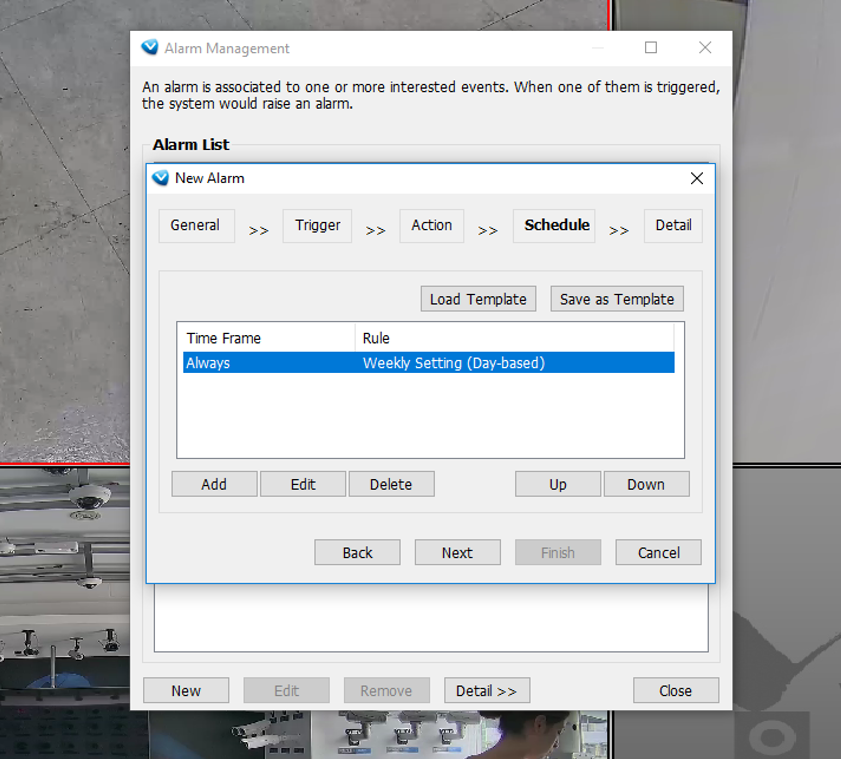
Note: you can modify the schedule if needed by selecting it and clicking on the “Edit” button.
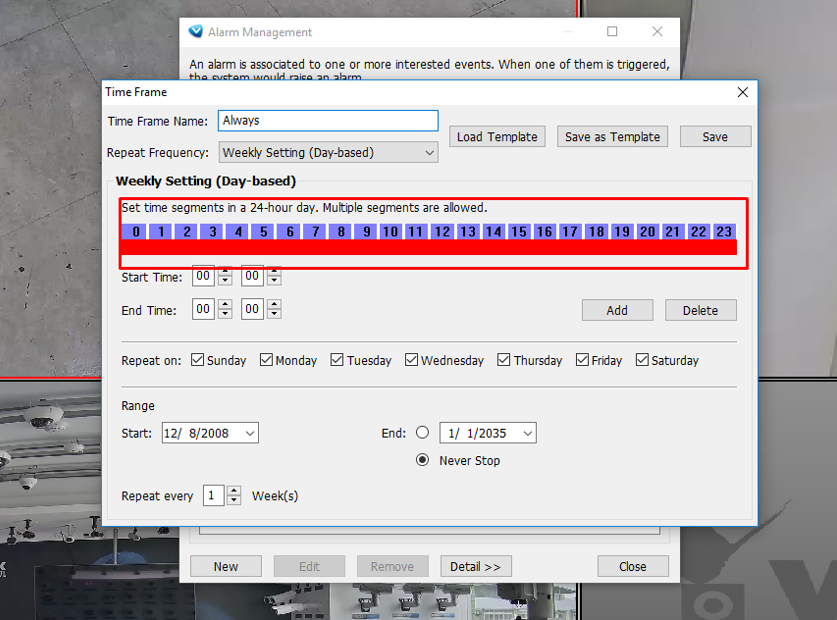
Step 13. In the “Detail” section, be sure that everything has been correctly saved and then click on the “Finish” button to save the alarm. 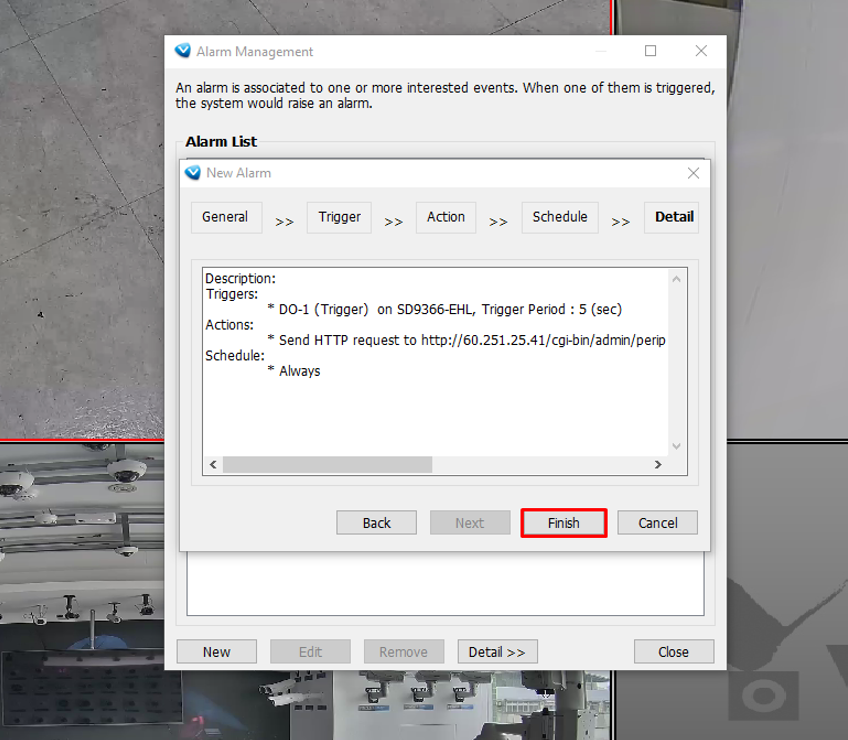
Step 14. You will see the new alarm listed in the “Alarm List”.
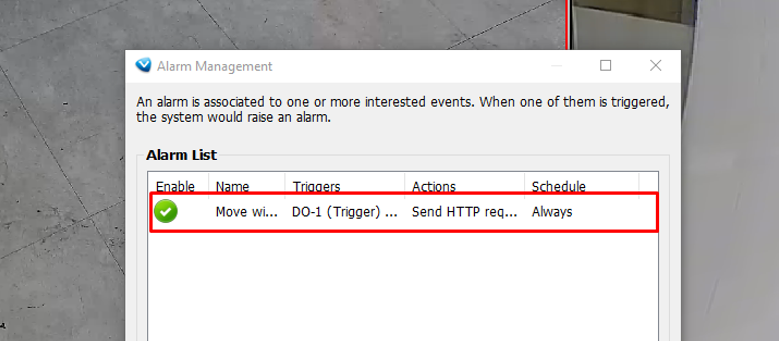
Step 15. To control the wiper, go to the “Device Tree” in the LiveView and click on the “+” icon, you will see the list of available triggers in the device.
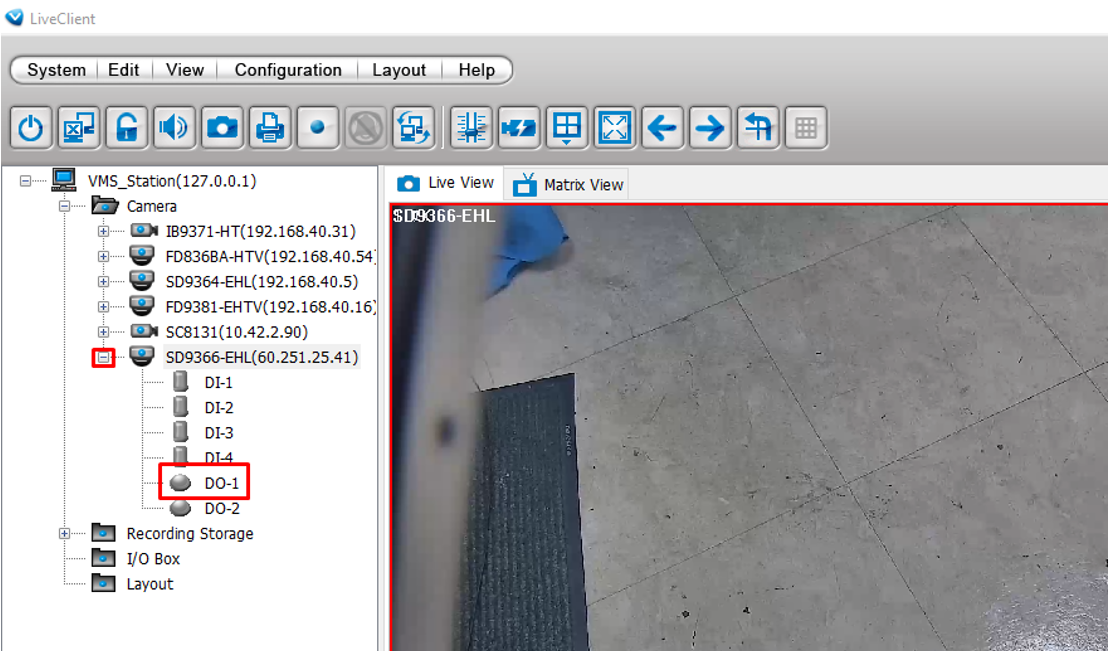
Step 16. Double click the “DO-1” to trigger the wiper.
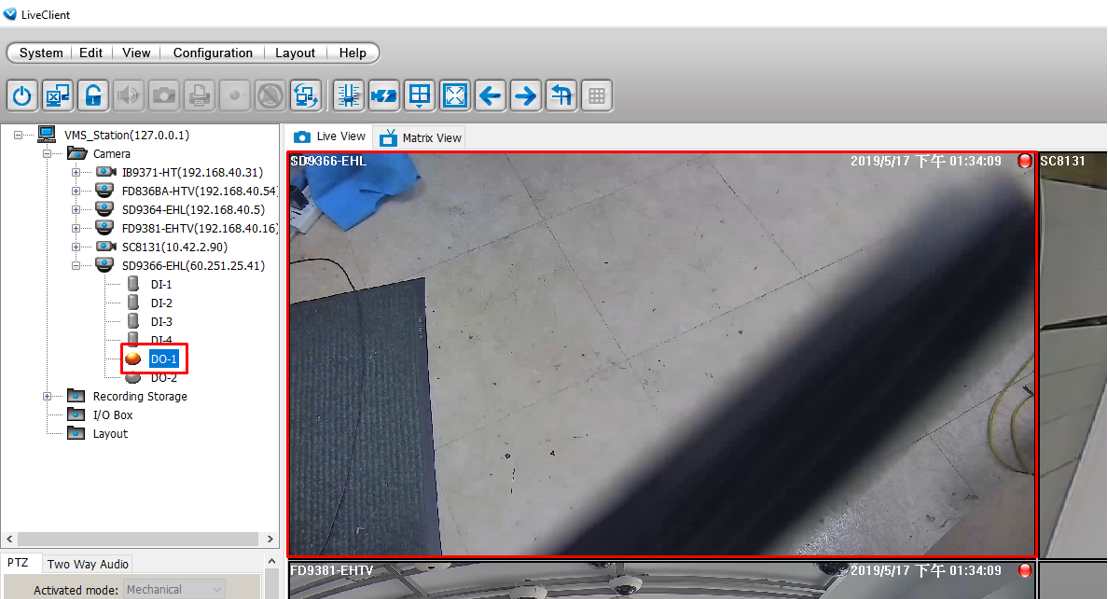
Camera indicator is visible in device tree but display black images in the LiveClient
Why does VAST LiveClient do not display camera videos on certain computers, even though it shows the camera name and recording indicator?
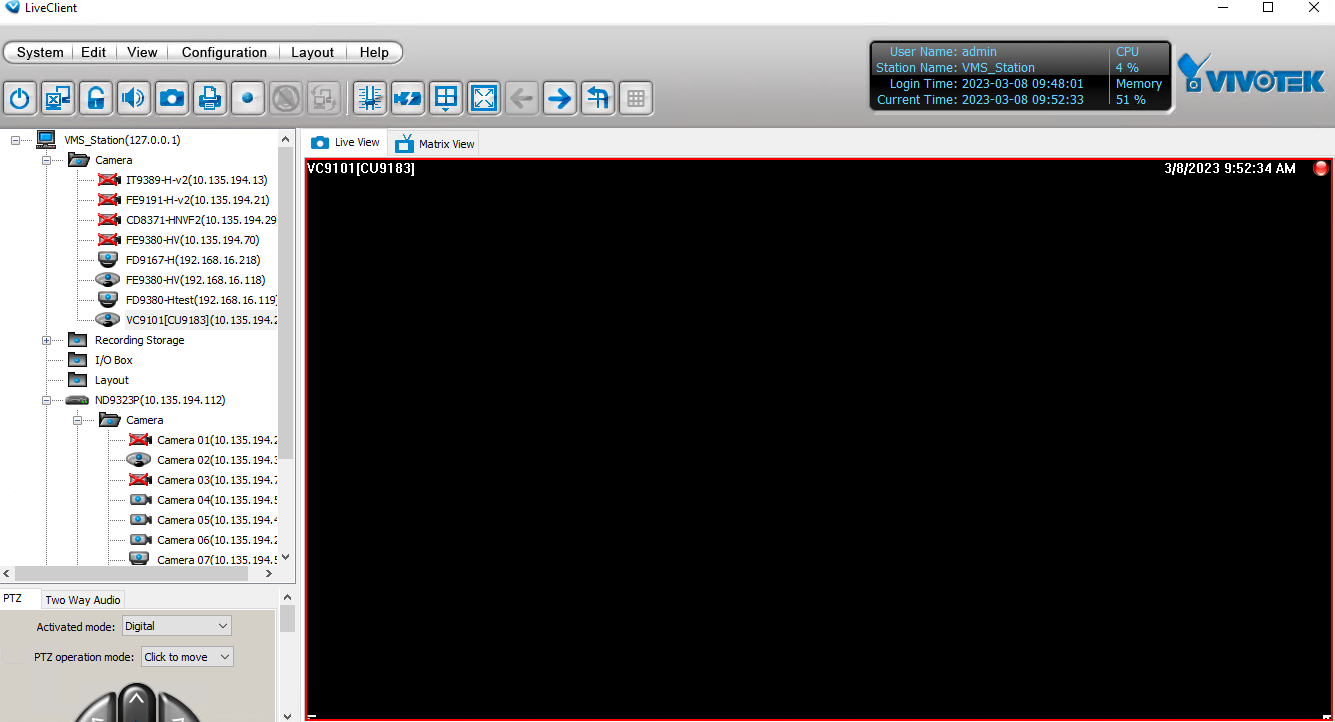
Answer
This issue typically arises when the computer doesn’t support the default render mode that VAST employs. You may resolve this problem by updating your computer’s GPU drivers. Alternatively, you could adjust the render mode that VAST uses. In order to manually change the render mode please follow the next steps:
Step 1. Close the LiveClient application. Note: If the LiveClient is not closed, the changed wont be saved.
Step 2. Go to the following folder: C:\ProgramData\VIVOTEK Inc\VAST\Client\LiveClient and using any editing tool (e.g Notepad++) open the following file: ClientSetting.ini. Once open, change the GDIOnly value to “1”
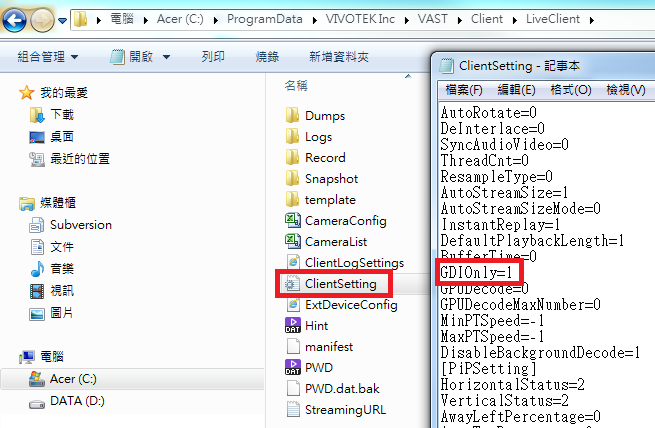
Step 3. After making the necessary changes, save the file. Close and then reopen the VAST LiveClient application. You should now be able to view the camera feeds.
Adding a substation to VAST
Introduction
This document describes how to easily add multiple cameras and ST7501- or VAST-based substations on other sites to a VAST server’s device list for centralized management.
How to add a substation to VAST
Please refer to the section “How to Manage Station” in the VAST user manual, which can be downloaded from the VIVOTEK website. You will find information on how to enable and configure the substation’s Relay feature (on either ST7501 or VAST) and how to add the substation to VAST’s device list for management.
How to manage substations
VAST supports the management of more than 64 cameras and multiple substations, allowing you to configure their settings and view video relayed from them.
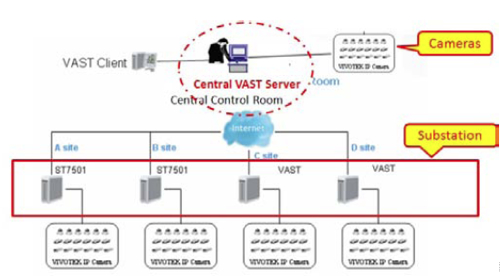
- Configuration
- To configure a substation, select its icon in the left panel of the LiveClient window and then click on the Configuration drop-down menu, or right-click on the icon and choose the setting page you desire from the pop-up contextual menu.
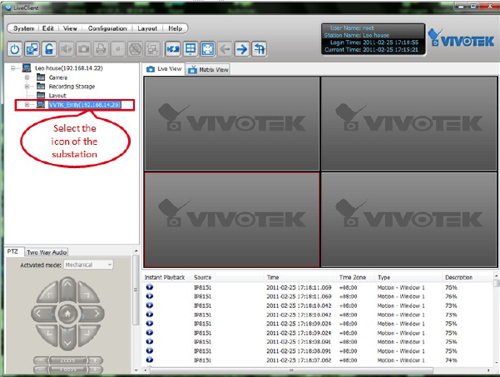
Select the icon of the substation
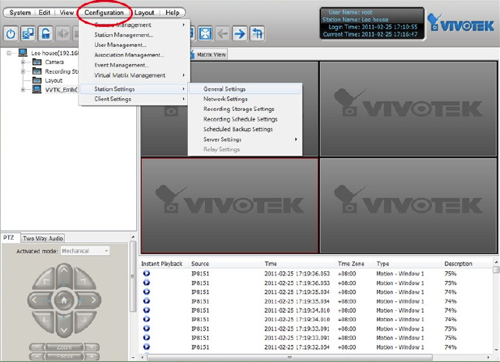
Click Configuration button to choose the settings page

Right-click on the icon and choose the setting page - To configure cameras connected directly to the central VAST server, select the icon for the main station in the left panel of the LiveClient window and then click on the Configuration drop-down menu or right-click on the icon and choose the setting page you desire from the pop-up contextual menu.

Select and right click on the icon of the main station and choose the setting page
- To configure a substation, select its icon in the left panel of the LiveClient window and then click on the Configuration drop-down menu, or right-click on the icon and choose the setting page you desire from the pop-up contextual menu.
- View cells: In the VAST LiveClient view cells, you can display video from a camera connected directly to the central VAST server and from a camera attached to a substation.
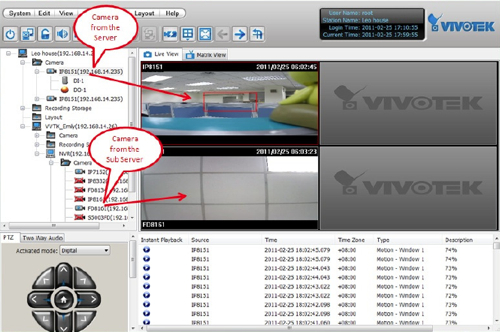
Troubleshooting
If you experience issues adding a substation to VAST’s device list, check the following areas.
- Relay settings: Make sure that the Relay feature of the substation is enabled and that you are using the correct password. For additional information, refer to the section “How to Manage Station” in the VAST user manual.
- If your VAST server is connected to the substation via Internet: Make sure that port 3454 (the port used for data communications) has been opened by the router on the substation side.
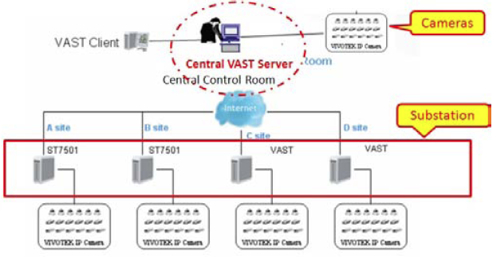
- If your VAST server and substation are on the same LAN: Make sure that any firewall or anti-virus software on the substation PC is not blocking connections to port 3454.

The following figures show an example using Microsoft Firewall of how to ensure port 3454 is available for connections.
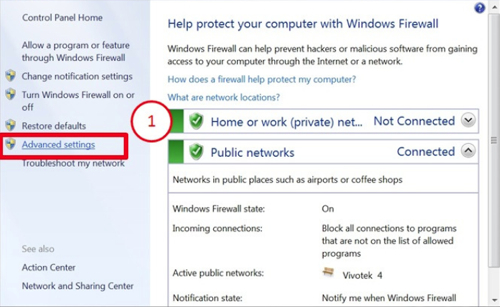
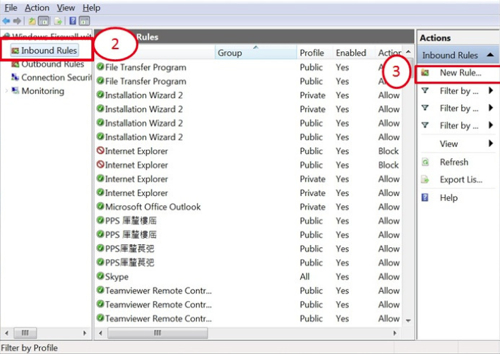
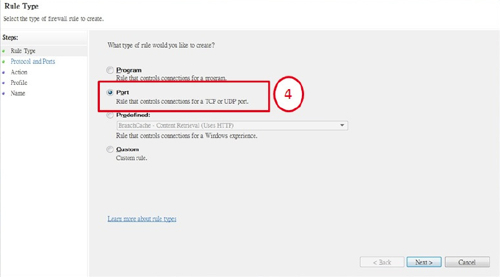
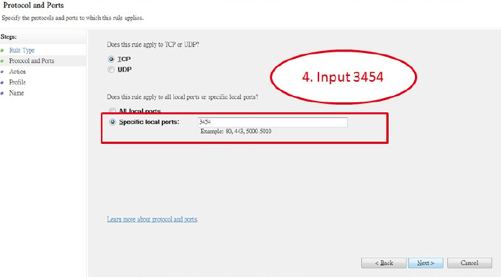
Cannot visualize plate images in data magnet after upgrading the software
Cannot visualize plate images in data magnet after upgrading the VAST2 software to version 2.7.0.5800.
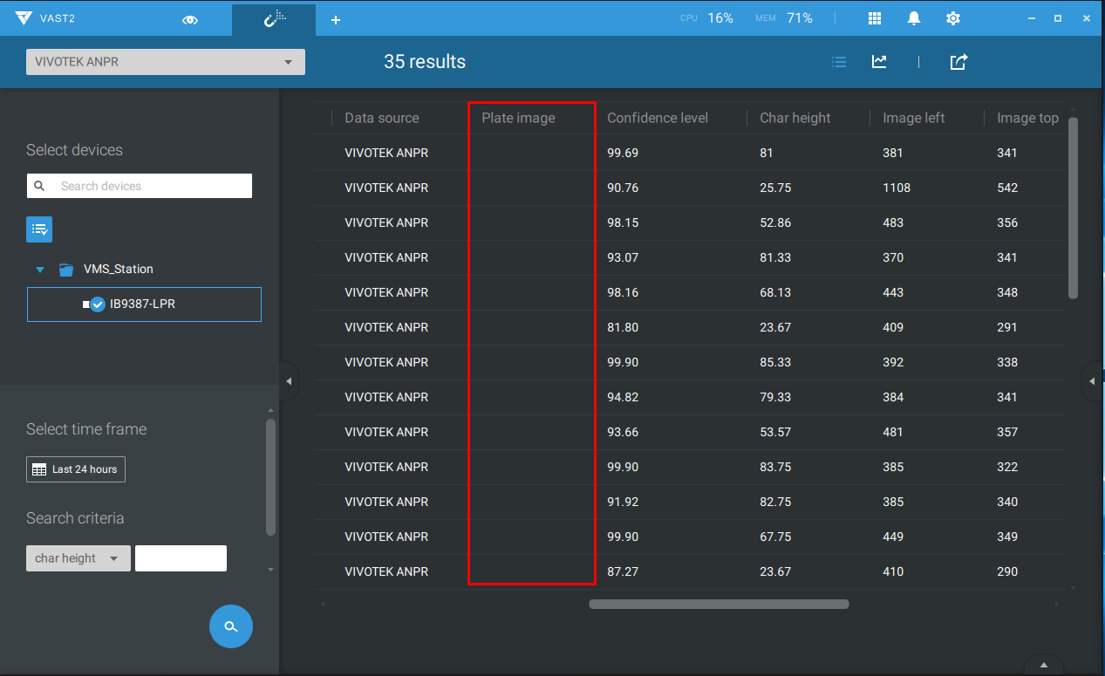
But the image can be visualized when accessing data magnet data in video cell.
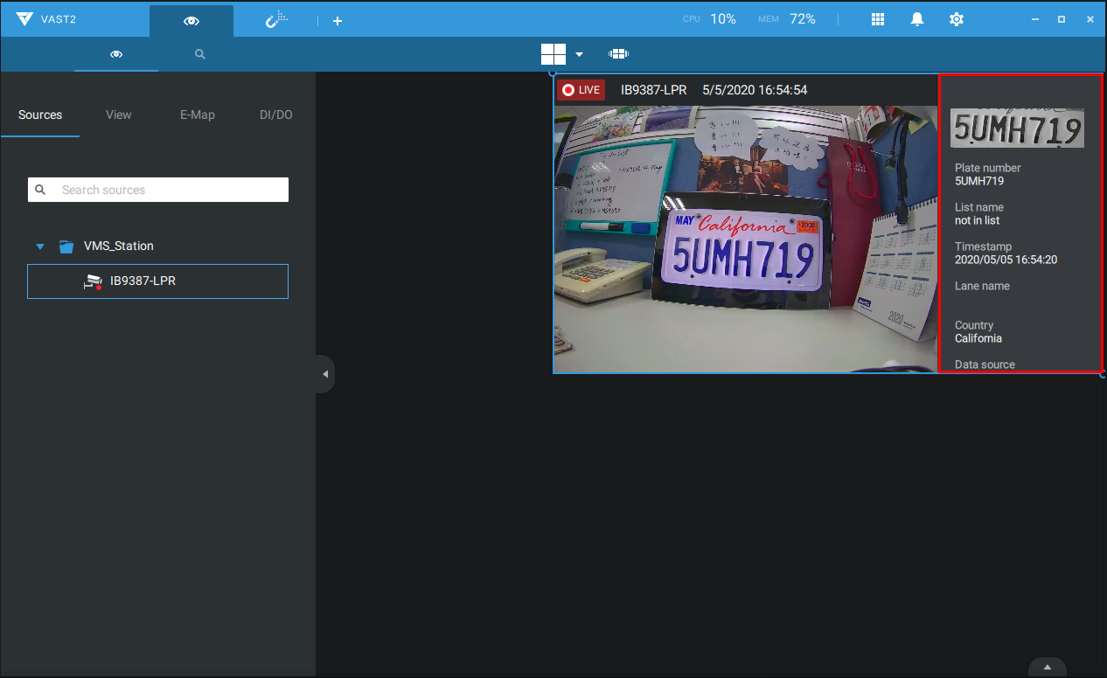
Answer
This issue was caused by an internal error in one of the modules of version 2.7.0.5800 and was resolved in version 2.8.0.6700 (or above). Please upgrade the software to version 2.8.0.6700 or above in order to resolve this issue. It can be downloaded in the following link: https://www.vivotek.com/vast2#downloads. After upgrading you should be able to visualize the plates normally in the data magnet list.
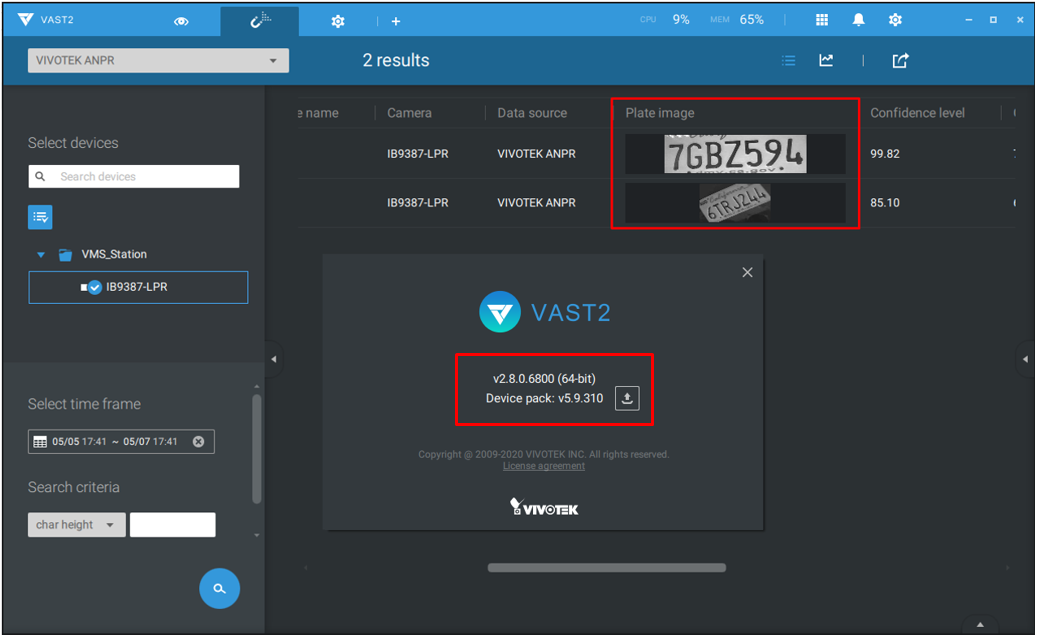
What is the workflow of the Seamless Recording function?
In this article, we’ll be exploring in detail the seamless recording flow between a camera and the VAST software. Understanding this process is vital for optimizing your use of the system and troubleshooting potential issues.
Seamless Recording function:
Seamless recording refers to a continuous, uninterrupted process of capturing and storing video footage. Meaning that the camera and the VAST will work together to ensure there are no gaps in the recording timeline.
If there any gaps, the VAST server will simultaneously retrieve the time-tagged videos that were temporarily stored on SD/SDHC/SDXC cards.
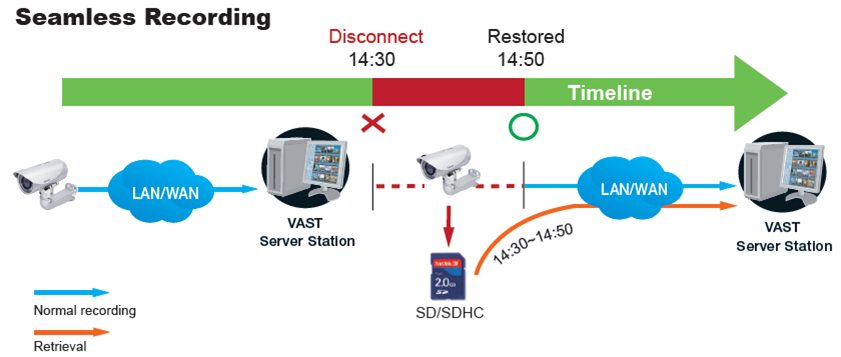
VAST software behaviour:
- VAST retrieves lost recordings at 1X speed.
- Seamless recording demands twice the bandwidth as it involves simultaneous normal recording and retrieval.
- Seamless recording also necessitates twice the storage write speed.
For instance, if the recording stream bitrate is 2Mbps, during simultaneous normal recording and retrieval, VAST requires twice the bandwidth, amounting to 4Mbps in this scenario. This also means that a storage write speed of 4Mbps is required.
Seamless Recording Flow
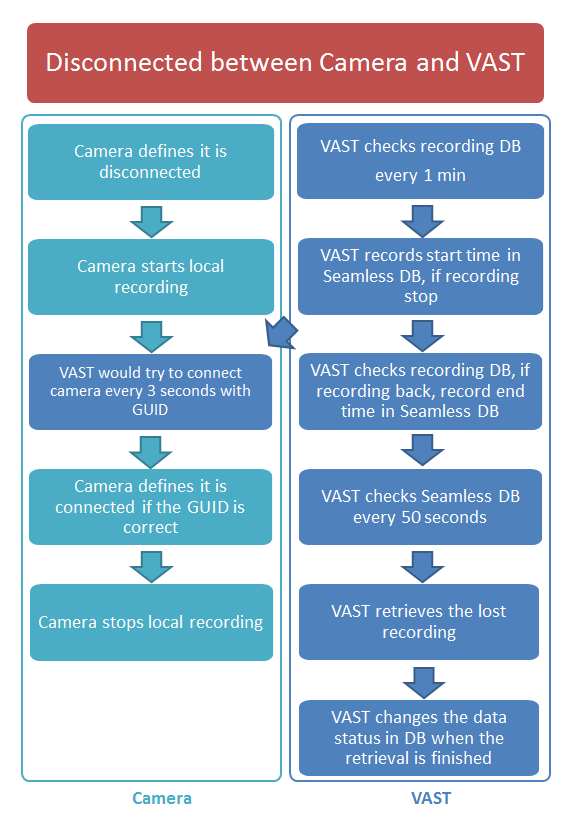
On the camera side, the methods for identifying disconnecting and reconnecting differ.
- Disconnect:
- TCP: If the camera does not receive a receiver report from VAST for 10 seconds, it will register as disconnected.
- UDP: The camera sends a sender report every 7 seconds. If it does not receive a receiver report from VAST twice consecutively, it will register as disconnected.
- Connect:
- VAST attempts to connect to the camera every 3 seconds using a GUID. If the GUID matches, the camera will register as connected.
Following this, lets see the following example. Suppose a camera is connected via TCP and UDP:
- For TCP: If the camera doesn’t hear from VAST for 10 seconds, it assumes it’s disconnected.
- For UDP: The camera sends a report every 7 seconds. If it doesn’t get a response from VAST twice in a row (around 14 seconds), it assumes it’s disconnected.
To reconnect, VAST tries every 3 seconds using a unique code (GUID). If the GUID is correct, the camera assumes it’s reconnected. In short, the camera and VAST constantly check in with each other. If they lose contact, they realize quickly and try to reconnect.
